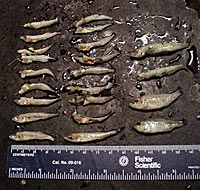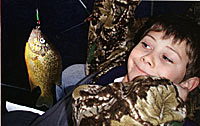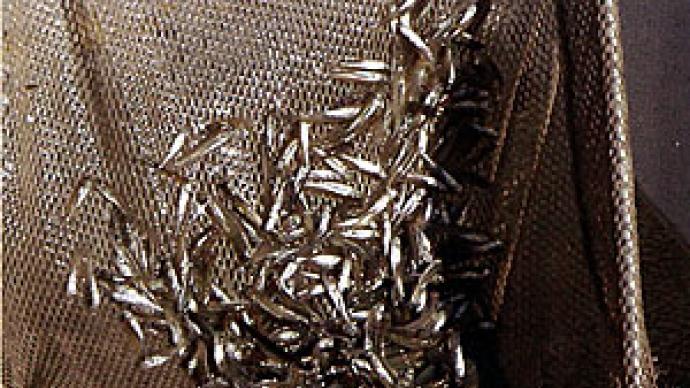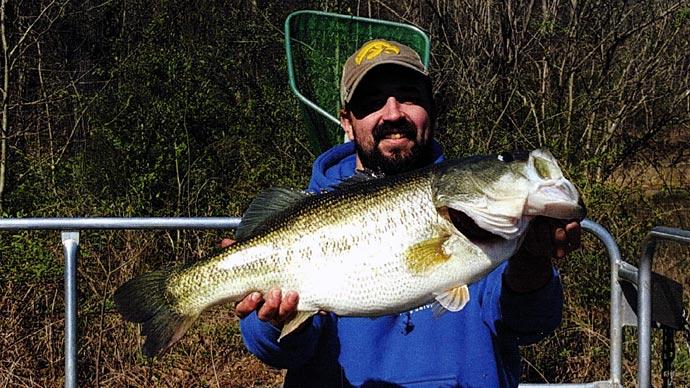
Spring is in full bloom and spawning season is well underway for warmwater fish across most of the country. That magical word... spawn... we hear it often each spring, but just exactly what does it mean? Spawn is a verb ... it's what fish do to reproduce. "The spawn" is a noun, used to define the time when fish move out of their comfort zones into the best environment where they can reproduce. Most fish develop eggs, which incubate and hatch. Different fish have different environmental conditions for eggs to hatch and for the new baby "fry" to develop.
This article delves into the tiny world of newly hatched fish. What's life like for a baby fish? Perilous, that's what it's like. What can you do to protect yours? Not a whole lot, really. Nor should you. But, depressing fates aside, their lives are interesting.
Most freshwater fish have similar early life stages. Adults lay eggs in a nest or broadcast them over some substrate, or even into open water. Eggs incubate and hatch depending on water temperature (colder water takes longer). Eggs hatch into "sac fry", which are little fish with a bulging yellow sac (think egg yolk) hanging off their abdomens, their source of nutrition for the first few hours or days of their lives. For many species, newly hatched sac fry may move very little. Salmon and trout sac fry hang out, almost motionless, on the bottom, in gravel, until their yolk sac is around 80% absorbed. During this chill out time, they do not feed and are hoping to be invisible. This may take a day or two ... or even several weeks, in the case of trout. After the yolk sac is absorbed, baby fish begin the quest to look for food. In fish culture circles, this is termed "swim-up" phase. Baby fish learn to feed at this time, surviving on a diet of microscopic plankton.
During early life stages, some species (like walleye and some types of sunfish) may be in open water (limnetic) and themselves be considered ichthyoplankton (free floating larvae), at the mercy of currents in the lake or pond. During this time, these planktonic game fish are extremely vulnerable to predation by open water schooling fish. Walleye populations have been all but eliminated in some lakes by intense alewife (a shad-like fish) predation on walleye fry. I have even caught larval sculpins in open water (traditionally thought of as bottom fish) in a surface sampling larval trawl, as they preyed on tiny baby fish. During this stage, most freshwater fish are clear or translucent so they blend with their surroundings. This larval period is considered a major time of dispersal and high mortality.

Other fish have different habits. Largemouth bass typically spawn in water 1 to 6 feet deep with males building a nest a few feet in diameter, using their fins and tail to sweep away debris from the bottom, down to a firm, clean substrate. The male attracts a ripe female to the nest; she and other females deposit eggs in the nest as the male fertilizes them. Daddy bass guards the nest and eggs hatch in 3 to 7 days. During incubations, he typically fans the nest to circulate fresh aerated water over the eggs. After hatch, bass sac fry remain in the nest bottom. until they are 3/4 to 1" long and reach the "swim up" phase (Smith, 1985). All baby fish start out by eating plankton and the largemouth is no exception. They disperse from the nest and feed on plankton and small invertebrates until they are about two inches long. Then they switch to the bombastic carnivores they are and begin feeding on a menu of a diet of other fish and whatever else they can fit in their mouth. During this time small bass are vulnerable and often found in the diets of other game fish, including their most aggressive brothers and sisters. Survivors grow to be the big, strong, savvy bass at the business end of your fishing pole.
As a fisheries biologist and hands-on professor, my students and I see the perilous nature of life for a 1 to 3 inch fish each spring. We typically see it in fish stomachs all around us, during our scientific expeditions. Take a look at the net full of baby walleye above.
I stock thousands of these walleye every year in a local lake. Now note the baby walleye and bass in the picture with the ruler. All of those partially digested fish came from the stomach of a single 16" largemouth bass stomach immediately after stocking young fish. There were 18 newly stocked walleye, two banded killifish and two wild baby largemouth bass in that stomach. Hold the phone ... bass eating bass? What else is new? This demonstrates what we all know, fish not traditionally thought of as prey fish in most circles are indeed eaten when available... even if they are your own kin. A baby bass is fair game to another bass (and so is everything else). That's the brutality of the food chain. Nature's way is to replace each parent... not populate the entire planet.
Smallmouth bass reproduction is similar, with males constructing and guarding the nest. Eggs hatch in one to three weeks with larvae remaining motionless in the gravel nest, absorbing their yolk sacs. When they hatch and are ready to swim up, fry are herded by the male in dense schools around the nest. Once schools break up and tiny smallmouth is on their own, they are heavily preyed on. Even if you are a predator like a largemouth, smallmouth or a walleye, mortality of fry and small fingerlings is often 99% or greater.

So, you may ask, who eats whom? You may have already figured out that, for small fish, things are not always what you expect. Mother Nature does not always follow the script that seems logical to us. Alewives, a traditional Northern baitfish, eat walleye and bluegill fry. Golden Shiners, minnows we buy most of the time from bait shops to catch bigger fish, are active meat eaters. They love to eat small fish. Weird? I once caught a two inch long largemouth in a larval fish sampling trawl in the middle of a 200 foot deep lake, a mile away from the nearest weed. Weirder? Was this largemouth bass lost? I think not. He was the fattest little bass I have ever seen. That bass was chasing larval alewife in open water. Another example? Just before yellow perch spawn in New York, the number one food item I find in their diet is, drum roll please ... baby bluegill. In my favorite crappie lake prior to spawn, what do you think I find most frequently in their stomachs? Mostly baby largemouth and baby bluegill. Guess what I fish with during this time? Yep, lures which imitate baby bluegill. I would love to tell you hard and fast rules about baby fish behavior. I know only one: If you are small, you are bait.

So, dear anglers, if you want to figure out who's eating who in your pond or favorite fishing hole, the first thing you need to do is get a good, scientific resource that can help you sort everybody out. For a good national publication, look at How to Know the Freshwater Fishes by Samuel Eddy, et al, available from Amazon.com. In New York, many of us use The Inland Fishes of New York State by C.L. Smith (1985). Here's why. Adult redbreast sunfish have an elongated opercular flap, and pumpkinseed have an orange (pumpkin?) dot on the back margin of the operculum, while bluegill have vertical bars on the body with a black dot on the soft lobe of the dorsal fin, at the back. Adults are easy to tell apart, and even my little nephew can do that in a snap. But, identifying baby fish of these species is difficult because most have developed none of the distinguishing features. A good resource would usually tell you too look at the gill rakers. Bluegill have long gill rakers, pumpkinseeds moderately long rakers and green sunfish have short stubby ones (poor fellows). If you want to tell them apart (unfortunately sometimes we have to, at night, using flashlights) it's best to consult a good book like Eddy or Smith (1985). Once you've got your resource book and have taken a few minutes to get to know it, it's time to go out and catch some fish (I know, it's hard work, but somebody has to do it). Remove the stomachs from a few of the fist as you fillet and put them on a flat tray or pan. You may want to rinse stomach contents gently with water, and you may need a magnifying glass to help see details. Now it's time to play biologist! Take a look a what you have, and look through the book and see if can figure out what you are looking at. Practice makes perfect. At the end of the day you will have a great meal and know with some confidence what your meal ate for lunch.
Reprinted with permission from Pond Boss Magazine



